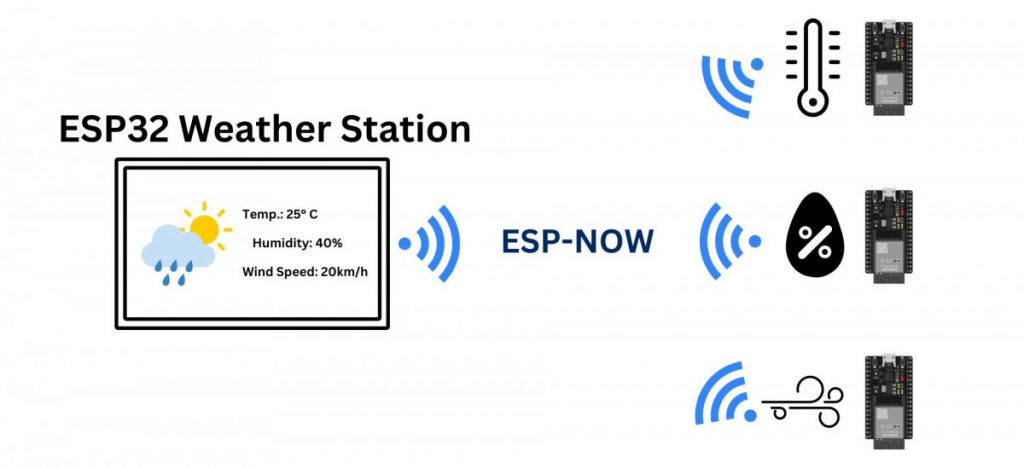ESP-NOW vs. Bluetooth — Choosing the right wireless communication protocol for your ESP32 project can be tough. What are the differences between ESP-NOW and Bluetooth, and which protocol best suits my project’s requirements?
If you are facing the same problem, keep reading this guide, where I explain all the most important differences and help you decide which protocol to use for your next (IoT) project!
Introduction to ESP-NOW
ESP-NOW is a low-power, connectionless communication protocol developed by Espressif and designed specifically for ESP32 and ESP8266 devices. Unlike traditional Wi-Fi or Bluetooth, ESP-NOW allows devices to communicate directly without establishing a formal connection, making it ideal for fast, low-latency data transmission.
If you want to learn more about ESP-NOW, read this article, in which I explain the protocol more thoroughly.
Common use cases for ESP-NOW
Very often, ESP-NOW is used by hobbyists to transfer smaller data packets between ESP microcontrollers without the need for a complex setup.
For instance, sensors that track the environment often use ESP-NOW to send the data over to a central ESP32 or ESP2866 control unit.
Another example is using ESP-NOW to build a wireless remote controller to control an ESP32-based game console, an RC car, etc.

Introduction to Bluetooth
Probably, you already know Bluetooth. It is a universal wireless protocol widely used in consumer electronics. The ESP32 supports both Bluetooth Classic and Bluetooth Low Energy (BLE).
Bluetooth Classic is designed for continuous, high-data-rate applications like audio streaming (e.g., wireless headphones), resulting in higher power consumption and longer range. Bluetooth Low Energy (BLE), on the other hand, is optimized for low-power data transfers with lower data rates and is ideal for devices that need to conserve battery life (e.g., smart home sensors).
Common use cases for Bluetooth/BLE
Bluetooth is used where devices need to be paired to smartphones or other third-party devices, like Bluetooth speakers.
For example, you could build an app-controlled robot that pairs with your phone via Bluetooth.
Another example is building your own Bluetooth speaker that requires a higher data bandwidth compared to ESP-NOW.

ESP-NOW vs Bluetooth: The Key Differences
| Feature | ESP-NOW | Bluetooth (BLE/Classic) |
|---|---|---|
| Range | Up to 200m in open fields | 10-50m BLE, up to 100m Classic |
| Power Consumption | Very low, ideal for continuous communication | Low for BLE, higher for Classic |
| Data Transfer Speed | Fast, suitable for small packets | Fast for BLE, even faster for Classic |
| Network Structure | One-to-many, many-to-one, many-to-many (peer-to-peer) | One-to-one (Classic), mesh (BLE) |
| Compatibility | ESP32 and ESP8266 devices only | Universally supported on many devices |
| Security | Supports CCMP encryption | Standard encryption protocols for both types |
| Reliability | High, with retransmission, CRC checks, and ACKs | Very reliable with frequency hopping (Classic) and error correction |
Bluetooth is more versatile for broader, well-established use cases and offers high compatibility with various devices. ESP-NOW, on the other hand, is more specialized and optimized for direct communication between ESP microcontrollers with low power consumption and low latency, typically in IoT and sensor networks.
Let’s dive a bit deeper into some of the points from the table:
Range
With 200 meters, ESP-NOW has about double the range of classic Bluetooth when used in an open environment. Even if you don’t need that big of a range, ESP-NOW can transfer data more reliably in a crowded environment with many obstacles.
Compatibility
Because of its universal support, Bluetooth is used in many consumer applications. You know Bluetooth from your phone, headphones, watch, and many other consumer electronic devices. ESP-NOW, however, is only supported by the ESP32 and ESP8266 microcontrollers, making it less suitable for pairing with various devices. Thus, its use cases are more specific (e.g., smart home sensors).
Security
Both protocols offer standardized encryption, but ESP-NOW’s peer-to-peer encryption has a slight edge over Bluetooth because there is no pairing and bonding mechanism. This reduces the risk of man-in-the-middle (MITM) attacks and misconfigured devices.
If you want to learn more about the encryption of ESP-NOW, read this article, in which I explain how to send encrypted messages with ESP-NOW.
Which Protocol is Better for Your IoT Projects?
I have created a little guideline for you to follow when choosing a wireless protocol for your next (IoT) project.
Use ESP-NOW if:
- You need long-range communication
- Power efficiency is critical, like in remote sensors
- You don’t need smartphone or third-party device compatibility
- You need low-latency communication for time-sensitive applications
- You prefer a simple setup without complicated bonding mechanisms
- You have a focus on security
Use Bluetooth if:
- You require smartphone integration or compatibility with third-party devices
- You want your project to be app-controlled
- Your project has a high data rate
- You want to integrate your project into existing Bluetooth ecosystems
- You need scalable networks of devices
ESP-NOW vs Bluetooth: Wrapping Up
Both ESP-NOW and Bluetooth have their strengths and are suited for different types of projects. If you need long-range, power-efficient, low-latency communication between ESP devices, ESP-NOW is your best bet. However, if you require universal compatibility with smartphones and other devices, or need higher data rates for applications like audio streaming, Bluetooth is the way to go
Do you have experience using ESP-NOW or Bluetooth in your IoT projects? Share your thoughts in the comments below!
Thanks for reading!
Links marked with an asterisk (*) are affiliate links which means we may receive a commission for purchases made through these links at no extra cost to you. Read more on our Affiliate Disclosure Page.

